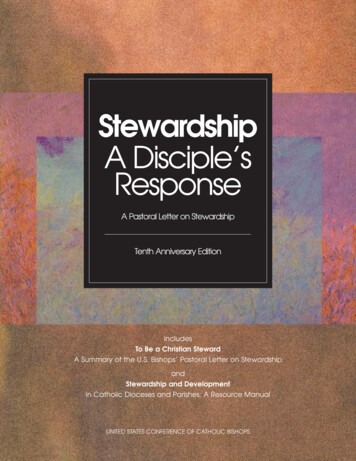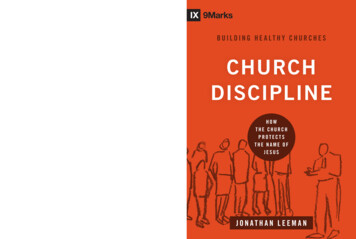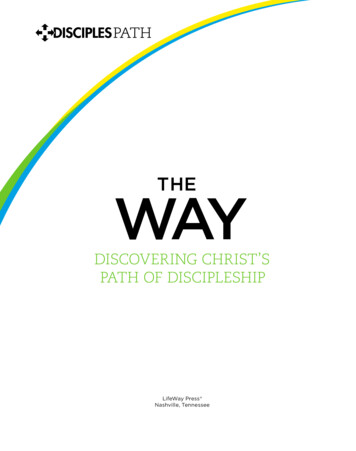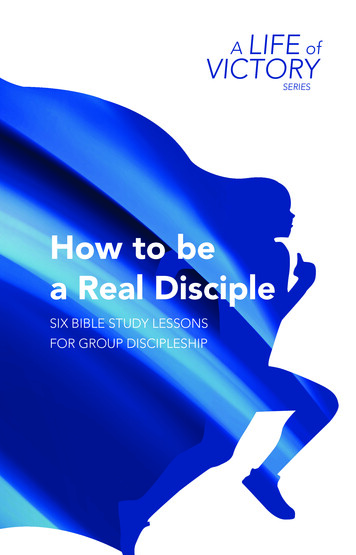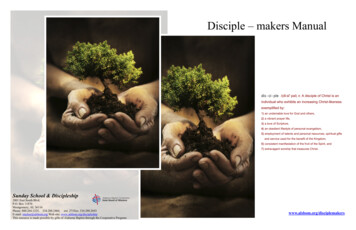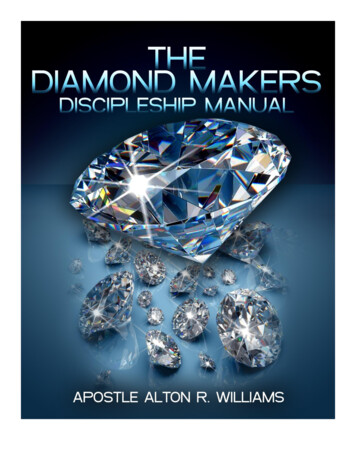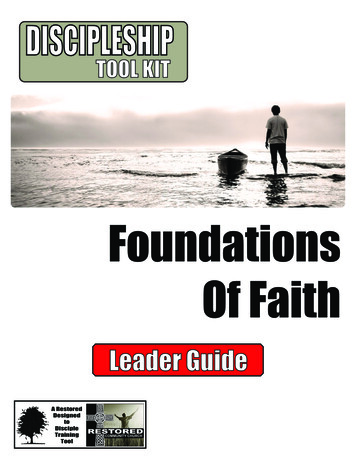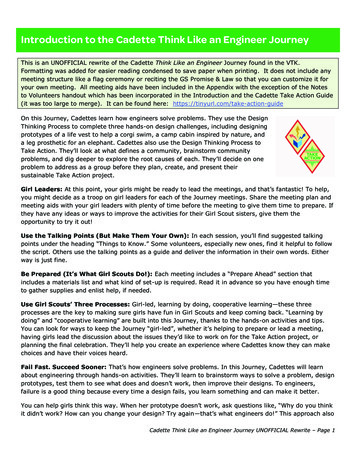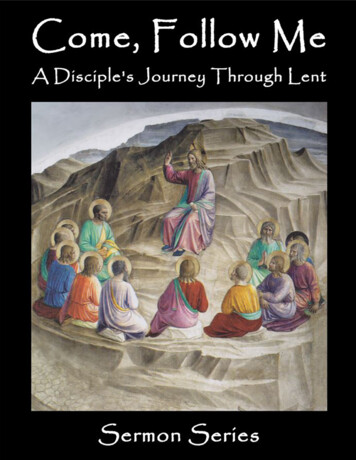
Transcription
Come, Follow MeCome, Follow Me:A Disciple’s Journey Through LentIntroduction to the Sermon SeriesSeveral years ago, a group of clergy in the South Carolina Annual Conference attended a continuingeducation event at Lake Junaluska. They came away with one question: How can we help peoplebegin to move from thinking of themselves as church members and to identifying themselves asdisciples of Christ? That question became the basis for “Come, Follow Me,” a sermon and study seriespublished by the South Carolina Conference in 2018. That study followed discipleship growth in theapostle Peter. Now comes another series for use during the season of Lent.Before looking at the series, I invite you to consider the foundational question concerning themovement from membership to discipleship. The question raised at Lake Junaluska was not a solitaryone. Other church leaders have wrestled with similar questions and written books concerning themovement from member to disciple. Some examples: “Deepening Your Effectiveness,” by Dan Glover and Claudia Lavy“Twelve Dynamic Shifts for Transforming Your Church,” by Stanley Ott“Shift,” by Mark TidsworthWhat is the concern and why? At its simplest, if we identify ourselves as members of the church, weare free to come and go at will – the condition of many contemporary civic and service organizations.If we identify ourselves as Christian disciples, everything we do falls under the authority and power ofChrist. We live our commitment to Christ through the church and through all our actions. Our lives areless about going to church and more about being the church. Our commitment to Christ becomes ourcommission to follow Jesus and to serve in the work of Jesus.“Come, Follow Me: A Disciple’s Journey Through Lent” looks at defining moments in Jesus’ ministry aspresented in the Gospel of Matthew. The five sermons are:Sermon 1: The Baptism of Jesus (Matthew 3:13-17) – Jesus sought baptism from John. Whatdoes it mean for us to be baptized into Christ?Sermon 2: Wilderness and Temptations of Jesus (Matthew 4:1-11) – Following the baptism,Jesus went into the wilderness. There he experienced severe temptation concerning hisidentity. What are the challenges to our identity as Christian followers? How do we face suchtemptation?2
A Disciple’s Journey Through LentSermon 3: The Beatitudes, Salt and Light (Matthew 5:1-16) – A crowd gathered to hear Jesus,who gave them a basic understanding of life within God’s kingdom. How are we embracing andliving these values of God’s kingdom?Sermon 4: Prayer and Attitude (Matthew 6:1-18) – Jesus continues to teach about theKingdom of God and different facets of discipleship. How are we engaged in the work ofintrospection, prayer, and fasting?Sermon 5: Healing, Exorcism, Service, Following (Matthew 8:14-27) – Jesus and his disciplesengage in hands-on ministry. What is our ministry? How are we following Christ in ministry andmission?We did not include a sermon for Palm/Passion Sunday, the sixth Sunday inLent, because of the many different congregational traditions on this day.Know that your church’s traditions will also guide the formation of disciples.Each chapter of this series includes these features (and a few more):Note to the Pastor – Some pastoral backgroundExegesis – A light introduction (you will do more digging)Sermon Outline – The big ideas of the sermonSermon – That which was preachedOther Illustrations – For use within contemporary and traditional settingHymn and Song Suggestions – Traditional and contemporary suggestionsBibliography – A working list of resourcesIn addition to the Sermon Series, a separate Leader’s Guide is available with suggestions for smallgroups. Each session in the Leader’s Guide include recommendations to help group participants or theentire congregation grow spiritually through different spiritual disciplines.We hope that the conversation about discipleship will guide all as we partner with God for thetransformation of the world.For the working group,The Rev. George DonigianRev. Donigian is an ordained elder in the South Carolina Conference.He is the pastor of Shiloh United Methodist Church in Piedmont.3
Come, Follow MeSermon 1: The Baptism of JesusWriter: Rev. Dr. Laura CanineScripture: Matthew 3:13-17Note to the Pastor:We will join with Christ in his baptism in the Jordan River – an event so significant that it finds its wayinto all four gospels. 1 We will see and hear the presence of the Holy Spirit and God’s declaration thathe is well pleased with his son. A common question that generally comes along with this Scripture:“Why was Jesus baptized if he was without sin?” Jesus explains that he needs to “fulfill allrighteousness” 2 and does so in complete obedience to God’s plan. In doing so, Jesus simultaneouslyaffirms John’s ministry and is able to identify with the people that he came to save.John baptized as part of a call to repentance and to encourage a complacent and even defiant nationto turn back to the God they had abandoned – but he also told his followers that Jesus would baptizewith the Holy Spirit, enlivening God’s power within them. In the Great Commission that he offers hisdisciples just before he ascends to heaven, Jesus again makes baptism an integral part of the missionto make disciples, telling them (and us) to “go and make disciples of all nations, baptizing them in thename of the Father and of the Son and of the Holy Spirit.” 3Having just walked through the penitential nature of Ash Wednesday, this is a most appropriateseason to consider that our baptism (and baptismal remembrance) is an intentional dying to sin. Toconsider that out of that death comes new life and a new identity as those saved by on overflowingmeasure of God’s grace. We will take time to reflect on our own baptisms as a pivotal point in ourjourney of salvation.As we know, the sacrament of baptism occupies a distinctive place in our faith and plays a vital role inthe life of the church. This visible sign of an invisible working of grace brings us to salvation andlaunches us on the road of holiness – both personal and social. So, what exactly does it mean for us tobe baptized into Christ? Because God works in and through baptism to connect us to the beauty of histransforming love in Jesus Christ, how does our day-to-day living change as a result?Exegesis: Matthew 3:13-17The name “Matthew” in Greek (Maththaios or Matthaios) is abbreviated from the Aramaic wordmeaning “gift of Yahweh” and occurs in the four lists of the Apostles (Matthew 10:3; Mark 3:18; Luke6:15; Acts 1:13). 4 The author of this Gospel traditionally has been accepted as Levi, the tax collector ofCapernaum, who was called by Jesus to follow him (Matthew 9:9; 10:3). 5 Some commentators note1Matthew 3:13-17, Mark 1:1-13, Luke 3:21-22, John 1:29-32.Matthew 3:163Matthew 28:194Clifton J. Allen, ed., The Broadman Bible Commentary, (Nashville: Broadman Press, 1969), 72.5W. Sunderland Lewis and Henry M. Booth, The Preacher’s Homiletic Commentary, (Grand Rapids: Baker Book House,1974), 1.24
A Disciple’s Journey Through Lentthat while Mark and Luke seem to distinguish between Matthew and Levi as two separate individuals,the Gospel of Matthew seems to present them as the same figure. 6 The Church Fathers grant that hisstatus as a disciple of Christ would have allowed him direct knowledge as an eyewitness to most of theevents of Jesus’ earthly ministry. Regardless of the speculation of the author’s identity, “Matthew ismore than a historian, more than a writer, more than an author, more than an editor or a scribe.Matthew can be more accurately described as an evangelist.” 7 As one who has been through atransformational conversion and received a new identity, he writes to all who will listen/read aboutserving the one who rescued him.Matthew’s audience seems to comprise Jewish Christians who would undoubtedly be familiar withMatthew’s explicit connections to Old Testament prophecy. They also would have knowledge ofcovenant language since God already had constituted a servant community of the people of Israel –promising to be their God and giving them the Law to make clear how they were to live. Matthewbuilds on that prior knowledge to offer that ultimately, in the death and resurrection of Jesus Christ,God fulfilled the prophecy of a new covenant (the sign of which is baptism rather than circumcision) 8and called forth the church as a servant community. 9 Such a covenant is sealed with those who believein the saving work of Jesus Christ and declared in baptism with a corresponding commitment offaith. 10 Baptism in itself would not have been a foreign concept as it is similar to purification rituals ofJudaism, but Matthew will portray throughout his Gospel that the Christian’s baptism represents thespiritually invisible sign of cleansing and forgiveness while analogous to Christ’s death, burial andresurrection. 11While not a formal biography or historiography, Matthew has painstakingly organized a recollection offamiliar accounts based on first-hand knowledge or the careful transmission of such knowledge.Because Matthew’s purpose is to familiarize readers with Jesus as the prophesied Messiah, the authorincludes records of Jesus’ teaching and healing, as well as genealogy, as evidence. The JewishChristians to whom Matthew writes may be characterized heavily by their faithfulness to Scripturallaw and their general familiarity with the Scriptures themselves. By accepting the Good News of JesusChrist, this community would embrace Jesus to be God’s promise to Israel as the fulfillment of the lawof the prophets.Central themes prevalent in Matthew include: The fulfillment of the prophets’ words involving Jesus as God’s promise of salvation.The identity of Jesus as servant/Messiah/Lord.The inclusion of Gentiles in God’s kingdom.A historical understanding of salvation in which the Scriptural story of Israel as the people ofGod becomes that of the church.God’s final victory evident in the establishment of God’s kingdom on earth.6Allen, 72.Grace Imathiu, Matthew’s Message, (Nashville: Abingdon Press, 1998), 1.8Genesis 17:1-14; Exodus 24:1-129Jeremiah 31:31-34; 1 Corinthians 11:23-2610Hoyt L. Hickman, ed., The Worship Resources of the United Methodist Church, (Nashville: Abingdon Press, 1989), 86.11Leviticus 13-17; Numbers 19; 1 Peter 3:21; Romans 6:3-5; Colossians 3:1275
Come, Follow Me A responsibility-based discipleship realized in obedience, righteousness and evangelism.One of Matthew’s unique traits is that it is the only Gospel in which the actual word “church” (ecclesia)is used, signifying Matthew’s intent to organize an authoritative record for new converts and olderbelievers to put their faith into daily practice. 12The Sermon OutlineThis sermon is intentionally short to allow space for a response with a Baptismal Remembrance. Itbegins with an attempt to have the congregation put themselves on the banks of the Jordan River toidentify with Jesus in the moment of his baptism. What must it have been like? The sights, smells,sounds and emotions are hard to imagine, but try to encourage the congregation to take a minute toput themselves in that place.I use a personal illustration next to share my experience with baptism and the covenant that was madeon my behalf, since it happened when I was an infant. Your congregation will want to hear about yourbaptism story. I have heard some poignant ones and some that are just downright humorous! This isalso done to plant some seeds as we begin to think about what it is that we remember (or what wehave been told) for our service of remembrance following the sermon.Next, I include space for teaching opportunities about the sacrament of baptism. If your congregationis like mine, you will have people covering the spectrum from mature saints baptized 90 years ago, tochildren who were baptized just a couple of months ago, to those who are vessels of God’s prevenientgrace and have yet to experience the sacrament. I believe it is important to speak to thecongregation’s corporate responsibility as part of the baptismal covenant. I use a humorous example(other examples are listed at the end of the sermon if you prefer to use one of them) to remind us howbaptism changes our identity and, as a result, substantially should change our witness in the world.Lastly, as we transition into the time of Baptismal Remembrance, I conclude this final section with areminder to the congregation and a word of hope. As we have just started the season of Lent and arebeing encouraged to examine our spiritual well-being, we are reminded that Christ was baptized sothat he would know what it would be for us to navigate our journey of salvation as his disciples. Iintend to leave the congregation with a feeling of hope (and also a bit of conviction and challenge!) inrecapping that our ultimate goal in being faithful disciples of Jesus Christ is hearing the same wordsspoken to Jesus on the day of his baptism: We are those in whom our Father is pleased.The Sermon“Then Jesus came from Galilee to the Jordan to be baptized by John. But John tried to deter him,saying, ‘I need to be baptized by you, and do you come to me?’ Jesus replied, ‘Let it be so now;it is proper for us to do this to fulfill all righteousness.’ Then John consented. As soon as Jesuswas baptized, he went up out of the water. At that moment heaven was opened, and he saw126John Drane, Introducing the New Testament, (San Francisco: Harper & Row Publishers, 1986), 191.
A Disciple’s Journey Through Lentthe Spirit of God descending like a dove and lighting on him. And a voice from heaven said,‘This is my Son, whom I love; with him I am well pleased.’” – Matthew 3:13-17 (NIV)I imagined what this moment must have looked like when I stood on the banks of the Jordan River ahandful of years ago. I put my hands in the muddy water that is only a few yards wide and barelywaist-deep. And I envisioned what it must have been like for John the Baptist to proclaim the words,“One who’s more powerful than I is coming; I am not worthy to carry his sandals.” (Matthew 3:11)I picture this eccentric man dressed in camel hair and eating locusts and honey, and people comingfrom all over the entire Judean countryside and all of Jerusalem to meet him there at the river to bebaptized and to confess their sins. Crowds of pilgrims would travel way out to the sticks – to the edgeof the border that crosses into the same land that God had promised to Abraham centuries before. Itwas a nearly 75-mile journey, and walking through the vast hills and desert terrain, you really had towant to get there. A simple glance at a map shows that there are also plenty of bodies of water closerto Jerusalem, but John was intentional about choosing to do his baptizing in the Jordan River becauseit symbolized the crossing from the old into the new and living into the promised covenant of God.There would have been a long line of people stretching down the riverbank and then all of a suddenwhen John looks up at the next person wading toward him, he notices that it is Jesus, standing there,waist-deep in the water. At this point, John cannot contain himself. He starts pointing at Jesus, as if tosay, “This is the one; the one who takes away the sins of the world!” And he humbly tells Jesus that it ishe who should be baptized instead of the other way around. Then suddenly, above Jesus’ head is theHoly Spirit, as a dove, descending. At that moment, the clouds part and the heavenly voice of Godproclaims, “You are my Son. My beloved. In you I am well pleased.” What an experience this musthave been for those who were there to take it all in! Even for those of us who were not there, we canstill imagine what that must have been like. Father, Son and Spirit – joined together in this moment ofsheer glory!Do you remember your baptism? If you were baptized as a baby, I am guessing probably not. But I betthat even if you were baptized as an infant, you probably still have some pretty early memories thathave something to do with your baptism. You may remember entering the church that your parentstook you to on Sundays and some other days during the week. Maybe you remember glimpses of thefaces of people who smiled at you and made you feel loved and important. You might remember yourSunday school teachers who taught you about the Bible. There may even be some snippets from ahandful of sermons you might remember.As an infant, my parents presented me before the church to be baptized. During that service, theymade a promise to God that they kept. While I do not remember my actual baptism (it was in aPresbyterian church in Irmo, South Carolina, in 1982), I do know that my parents and the congregationof that church proclaimed the Good News and promised to live according to the example of Christ.Twelve years later, there came a day when I reaffirmed my baptism and accepted God’s free gift ofsalvation for myself during confirmation. I am so grateful that my life has never been the same! And I7
Come, Follow Mecannot wait to share with some of our young people as they choose to receive that gift and promise tolive out that journey of faith here in another few months when they are confirmed.Now, if you were baptized as a youth or an adult, your baptism was an outward sign of the conversionyou experienced. You might remember that moment and what it felt like better than some of the restof us. In fact, you still might be able to recall the exhilarating feeling of the water rushing over you,cleansing away your old self and your past sins and that warmth of God’s Spirit flooding over you.No matter our age or where we are on our faith journeys, as members of this congregation, we haveall taken part in the baptismal covenant at some time or another. Whether we have really paidattention to the words of the liturgy in the hymnal or we have just spoken them out of rote habit, wehave all pledged to be an example to those who are baptized in this house of God. We have made apromise to the children and adults who have been up here that we will reject sin in our lives andreaffirm our commitment to Christ so that we can live as Christian examples to those new believers inour midst. And we have promised to surround our brothers and sisters in Christ with a community oflove and forgiveness so they can grow in their faith and be true disciples who walk in the way thatleads to life.Here at First Church, we celebrate the baptism of people of all ages and all walks of life because wetrust that God’s grace is working in our lives – from before the time we’re born – to bring us to thatpoint in our lives where we accept God’s gift of salvation through faith in Christ. God claims us as hisown, which is why we Methodists do not believe in re-baptism. We are only baptized once becauseGod’s grace is always sufficient. God never makes mistakes. God does not need a “re-do.” In thatmoment when the water cleanses us, we claim God and God claims us. God puts his seal on our livesand we enter into a covenant to love and follow God. We promise to die to self and strive to put Godand God’s kingdom first. The reality though, is that because we are human, we need lots of “re-dos.”You and I have to constantly reaffirm and recommit ourselves to God if we are to live faithful,intentional lives in service to God.After the baptism of his baby brother in church, young Jason sobbed uncontrollably all the way homein the back seat of the car. His parents asked him three times what was wrong. Finally, the little boymanaged to give a pitiful sounding reply. “That pastor said he wanted us brought up in a Christianhome, but I want to stay with you guys!” Our baptisms should change us from the inside out andpeople (even our children) should be able see that!This morning, we are using this sacred time to be more intentional about claiming the promise madeat our baptism when we vowed to live as God’s children – not only inside these walls, but with ourfamilies, friends, co-workers, neighbors and anyone who needs to see and know the love, forgivenessand grace of Jesus. Today, we celebrate that crossing over from the old into the new and living intothe promised covenant of God.God was “well pleased” with his son on the day of Jesus’ baptism. Today, as we begin this Lentenjourney together, we remember what our baptism has meant to us. And for those of us who cannotremember our actual baptisms, we can celebrate the covenant that was made on our behalf and our8
A Disciple’s Journey Through Lentfaith journey that has followed as a result. You and I have the opportunity to renew our faith anddedicate our lives to God’s glory so that one day when we see God face to face, God will say to us,“Well done, good and faithful servant. You are my child, whom I love, and with you I am well pleased.”Let today be an epiphany for us and may it mark the beginning of an amazing journey between God,one another and ourselves. —————As the sermon concludes, it leads into reaffirming our baptismal covenant together using theReaffirmation of the Baptismal Covenant (United Methodist Hymnal 50).Note: After participating in the reaffirmation, you might wish to invite the congregation to the altararea for a time of prayer and thanksgiving. You might want to use the baptismal font or a large bowlof water. I like to put seashells or river rocks in the water so that as people dip their hands into thewater, they also may take with them these symbols of remembrance while embracing their identity asthose who are baptized in Christ. For those who have not yet been baptized, I also use this time toinvite them to participate as a means of God’s grace beginning to work through them.Another Illustration Johnny’s mother looked out the window and noticed him “playing church” with their cat. Thecat was sitting quietly and Johnny was preaching to it. His mother smiled and went about herwork. Later, she heard loud meowing and hissing and she ran back to the window to seeJohnny baptizing the cat in a tub of water. She called out, “Johnny, stop that! The cat’s afraidof water!” Johnny looked up at her and said, “He should’ve thought about that before he joinedmy church.”Hymn and Song Suggestions “I Surrender All” (UMH 354) – A classic hymn recounting the journey of salvation thatpurposefully repeats the theme of complete submission and surrender, so much so that if theentire hymn is sung, the singer will give voice to the word “surrender” 30 times and “all” will besung 43 times. “Lord, Who Throughout These Forty Days” (UMH 269) – This Lenten hymn recounts Christ’searthly journey on our behalf, including the depths of his fasting, praying and battling Satan’stemptations on the way to the victory of Easter. “Nothing But The Blood” (UMH 362) – This hymn recalls the cleansing action within the graceof baptism through Christ’s atonement by asking the question: “What can wash away my sin?”And the emphatic response is “nothing but the blood of Jesus.”9
Come, Follow Me “Spirit Song” (UMH 347) – “Spirit Song” celebrates the work of the Holy Spirit, which also givesvoice to the imagery of God’s Spirit, like a dove, descending on us just as he did with his son inthe moment of his baptism. “Wash, O God, Our Sons and Daughters” (UMH 605) – A more modern hymn with beautifulimagery asking God to continue His baptismal work, such as: “We your people stand beforeyou, Water-washed and Spirit-born. By your grace, our lives we offer. Re-create us; God,transform!” “When Jesus Came to Jordan” (UMH 252) – In this hymn, Fred Pratt Green traces the accountof Matthew 3:13-17 and offers theological implications for what is to come. “At the Font We Start Our Journey” (The Faith We Sing 2114) – Using baptism as the startingplace, this hymn seeks to connect Christ’s road to the cross and victory over death to ourjourney of salvation. “Grace Like Rain” (Todd Agnew) – This is a more contemporary take on “Amazing Grace,”which incorporates the water symbolism of baptism in God’s grace, like rain, falling down onus. “Washed By The Water” (Needtobreathe) – Written and performed by a local band from SouthCarolina, this folksy song tells the story of a pastor/evangelist’s son who shares that his fatherwas, at one time, the subject of rumors and accusations. He recounts how it made the singerand his mother feel and that all the while, whatever they were made to endure during thispoint in their ministry, he was able to hold onto the promise that “even when the rain falls,even when the flood starts rising, even when the storm comes, I am washed by the water.”Video Suggestions10 “O Brother, Where Art Thou?” (2000) – Three prisoners have escaped from a chain gang. Intheir journey to freedom and what they believe to be buried treasure, they come across lines ofpeople all dressed in white as they process through the woods and down toward the riverbank.The men are mesmerized by what they see and the beautiful music they hear being sung in thebaptismal procession, so they join the line and make their way to the river. Two of the menrush down into the water to be baptized by the pastor. After he emerges from the water, thefirst convict says that the pastor told him that all of his sins have now been washed away inbaptism! Even, he says, when he stole that pig, which is why he had been convicted. “But yousaid you were innocent of that,” his friend declared. “I lied,” he said, “and that’s been washedaway, too!” “Jesus of Nazareth” (1977) – John the Baptist passionately calls the crowds to consider theirsins and repent. Afterward, there is a poignant depiction of Jesus’ baptism.
A Disciple’s Journey Through Lent YouTube clip of 6-year-old boy’s baptism (bit.ly/boybaptized) – One of several clips availableon YouTube showing children who are so excited to be baptized that they take matters intotheir own hands. Oh, that we all might share in that enthusiasm and joy for the opportunity atnew life in Christ!Idea for ChildrenSince our church is near the beach, we have access to a variety of different seashells. For a fun objectlesson, you may wish to take a shell (large scallop or clam shells would be ideal) and attach coloredpictures of a dove and John baptizing Jesus inside the shell as a reminder of the beginning of Jesus’earthly ministry. You also might wish to use hot glue to attach a piece of string to use as a hanger. Ifyou do not have access to actual shells, you might print these images:Prayer Resources “An Invitation to Christ” (UMH 466) “Baptism of the Lord” (UMH 253) “Prayer for a New Heart” (UMH 392)Further Reading “Conversion in the Wesleyan Tradition,” by Kenneth Collins and John Tyson (Abingdon Press,2001) – This collection of essays explores the biblical, historical, theological, and practicalimplications of conversion within the Wesleyan tradition.11
Come, Follow Me12 “Faith Forming Faith: Bringing New Christians to Baptism and Beyond,” by Paul Hoffman, withforeword by Diana Butler Bass (Cascade Books, 2012) – Using a Lutheran congregation inSeattle as a model, Hoffman describes that church’s intentional year-long ministry (of whichbaptism is a central part) rooted in mentoring by more seasoned believers, which is designedto propel new believers into mission and service. “Invitation to a Journey: A Road Map for Spiritual Formation,” by M. Robert Mulholland Jr. (IVPBooks, 2016) – This book speaks to Christians in all places on their faith journeys andencourages believers to engage in purposeful spiritual formation as “the process of beingformed in the image of Christ for the sake of others.” This call to introspective work and faithcommitment for the sake of others also incorporates baptism as a covenant made as part of acorporate journey on which we all embark together. “The Holy Spirit in the Life of Jesus: The Mystery of Christ’s Baptism,” by RanieroCantalamessa (Liturgical Press, 1994) – Written by a Catholic priest, this work focuses on therole of the Holy Spirit in Christ’s life at the time of his baptism and throughout his earthlyministry through the time of his ascension, when he instructs his disciples to wait for that samespirit. “United Methodists and the Sacraments,” by Gayle Felton (Abingdon Press, 2007) – A practicalguide for those looking to know more about baptism as a sacrament within the UnitedMethodist Church. “By Water and the Spirit: A United Methodist Understanding of Baptism,”also by Felton (Discipleship Resources, 2003), is an excellent denominational resource.
A Disciple’s Journey Through LentBibliographyAllen, Clifton J., ed. The Broadman Bible Commentary: Matthew-Mark (Vol. 8). Nashville:Broadman Press, 1969.Drane, John. Introducing the New Testament. San Francisco: Harper & Row Publishers, 1986.Hickman, Hoyt L., ed. The Worship Resources of the United Methodist Church: Introduction to theGeneral Services, Psalter, and Other Acts of Worship. Nashville: Abingdon Press, 1989.Imathiu, Grace. Matthew’s Message: Good News for the New Millennium. Nashville: AbingdonPress, 1998.Lewis, W. Sunderland and Henry M. Booth. The Preacher’s Homiletic Commentary: Matthew.Grand Rapids: Baker Book House, 1974.The Rev. Dr. Laura Canine is an ordained elder in the South Carolina Conference.She serves as the pastor of First United Methodist Church-Isle of Palms.13
Come, Follow MeSermon 2: Wilderness TemptationsWriter: Rev. Erik GraysonScripture: Matthew 4:1-11Note to the Pastor:Nestled between the baptism of Jesus and the start to his public ministry, this sermon on thetemptations Jesus experienced in the wilderness can serve as a reminder that we have to own ourChristian identity in the midst of temptation.Jesus demonstrates that he understands the role of the Son of God to be about fidelity andfaithfulness to God. The three temptations ultimately revolve around the question of who the Son ofGod is going to be.The first temptation has to do with Jesus’ affiliation with hum
A Disciple’s Journey Through Lent 3 Sermon 3: The Beatitudes, Salt and Light (. Matthew 5:
